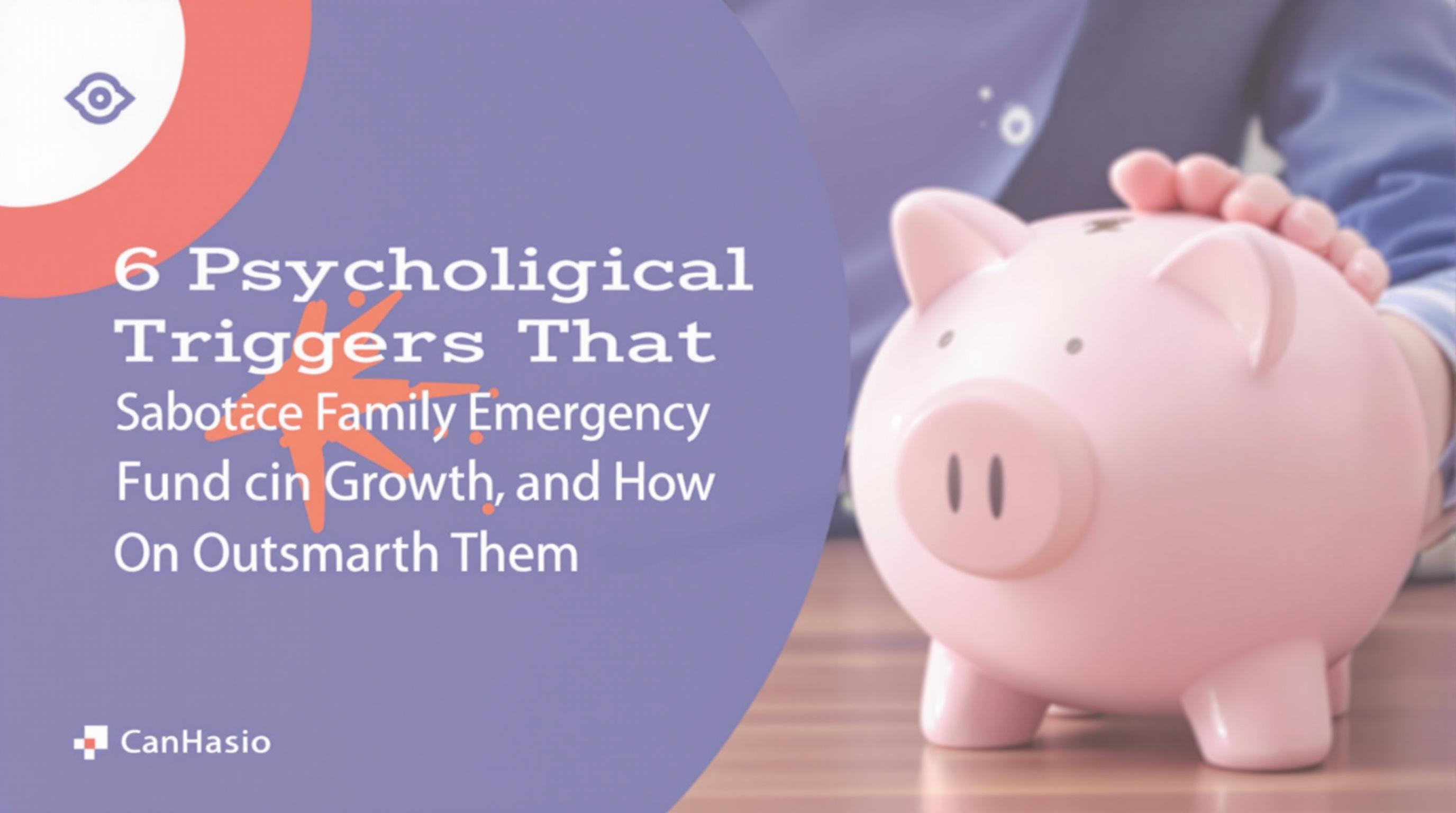Related Articles
- Top 5 Eco-Friendly Wallets Released Since 2019 That Blend Style with Smart Money Management
- Unlocking the Psychology of Spending: How Emotional Triggers Sabotage Your Saving Habits Without You Noticing
- Top 6 Revolutionary Micro-Investment Tools Launched Since 2019 Transforming Family Emergency Cash Reserves
- Top 6 New Credit Builder Cards and Apps From the Past Five Years That Actually Speed Up Your Score Growth
- Top 6 Innovative Debt Restructuring Tools from 2019 to 2024 That Outsmart Traditional Refinancing Options
- How Identity Protection Plans Intersect with Cyberpsychology to Influence Consumer Behavior and Risk Perception
6 Psychological Triggers That Sabotage Family Emergency Fund Growth and How to Outsmart Them
6 Psychological Triggers That Sabotage Family Emergency Fund Growth and How to Outsmart Them
6 Psychological Triggers That Sabotage Family Emergency Fund Growth and How to Outsmart Them
1. Instant Gratification Bias
Humans have a deep-rooted tendency to seek immediate rewards rather than wait for delayed gratification. This instinct stems from our evolutionary past, when obtaining quick resources meant survival. In modern finances, this bias manifests as impulse spending, which cuts into the funds designated for emergencies.
When faced with temptations such as attractive sales or new gadgets, families often prioritize these wants over growing their savings. The emotional thrill of acquiring something new temporarily overshadows the abstract future benefit of an emergency fund. This sporadic spending significantly slows down the accumulation of crucial reserves.
How to Outsmart: To counter instant gratification, automate transfers to your emergency fund immediately after each paycheck. Automating removes the need for a moment of choice, making saving a default behavior. Additionally, visualize the peace of mind that a fully funded emergency account can bring to reinforce long-term goals over short-term desires.
2. Optimism Bias
Optimism bias leads people to believe negative events are less likely to happen to them compared to others. This psychological trigger causes families to underestimate the probability of emergencies such as job loss, illness, or unexpected repairs, thus deprioritizing emergency savings.
Because emergencies feel distant or unlikely, individuals delay saving or contribute insufficiently to their emergency fund. This dangerous under-preparation means that when crises do hit, the financial impact is more severe and stressful, often forcing debt or liquidation of other assets.
How to Outsmart: Confront optimism bias by reviewing statistics and real-life stories related to unexpected expenses. Understanding that emergencies are a universal reality can motivate consistent contributions. Setting realistic savings targets and periodic reviews helps maintain awareness and commitment.
3. Mental Accounting Fallacy
Mental accounting is a cognitive bias where people treat money differently depending on its source or intended use. For instance, families might view a tax refund or bonus as “extra” money and spend it frivolously, rather than placing it in the emergency fund.
This mental compartmentalization leads to inconsistent saving behaviors and missed opportunities to bolster financial security. Such partial saving habits prevent the emergency fund from reaching a safety threshold fast enough to handle crises effectively.
How to Outsmart: Treat all windfalls and extra income as parts of your emergency fund goal. Label these inflows as non-negotiable savings and deposit them immediately. This strategic reclassification helps avoid spending temptations associated with "found money." Additionally, budgeting every dollar systematically reduces mental accounting pitfalls.
4. Loss Aversion
Loss aversion is the tendency to prefer avoiding losses rather than acquiring equivalent gains. This psychological trigger paradoxically causes some families to avoid investing their emergency fund in low-risk accounts because they fear any risk might cause losses.
While caution is critical for emergency funds, extreme risk aversion may result in funds languishing in accounts with negligible interest, eroding their value over time due to inflation. This reduces the actual purchasing power available when emergencies occur.
How to Outsmart: Educate yourself about safe, interest-bearing savings vehicles like high-yield savings accounts or short-term certificates of deposit (CDs). Accepting minimal but calculated risks can help your emergency fund grow modestly, preserving and increasing value over time without significant exposure.
5. Financial Stress Paralysis
When families are under considerable financial strain, the psychological burden can lead to paralysis by analysis — a state where worry and overwhelm inhibit action. This emotional overload stalls efforts to establish or grow an emergency fund because the problem feels insurmountable.
Stress weakens decision-making and creates avoidance behavior, perpetuating a dangerous cycle of inadequate savings. Families caught in this trap find it difficult to prioritize emergency funds amidst immediate financial demands and emotional fatigue.
How to Outsmart: Break down emergency fund goals into small, manageable steps. Start with micro-savings milestones to build confidence and momentum. Seeking support from financial advisors or counselors can help manage stress and develop realistic, actionable plans tailored to your circumstances.
6. Social Influence and Comparison
Humans are social creatures influenced by peers and societal norms. When family and friends prioritize consumerism over saving, it creates pressure to conform, leading to depleted finances and neglected emergency funds.
Constant exposure to the lifestyles of others through social media intensifies this effect, making families feel inadequate if they cannot keep up financially. This comparison trap diverts resources to appearances rather than preparedness, weakening financial resilience.
How to Outsmart: Limit social media exposure related to material displays and focus on your unique financial journey. Surround yourself with like-minded individuals who value financial security. Setting clear, personal financial values empowers families to resist social pressure and prioritize emergency fund growth.
7. Overconfidence Effect
Overconfidence leads individuals to overestimate their ability to handle financial setbacks without an emergency fund. Believing they can quickly bounce back discourages consistent saving, leaving them vulnerable in actual crises.
This psychological trap delays the urgency to build a safety net until confronting a severe emergency, which is often too late to avoid debt or hardship. Overconfidence impairs realistic financial planning and risk assessment.
How to Outsmart: Periodically review your financial situation by simulating potential emergencies and estimating the associated costs. Awareness of your true risk tolerance and contingency needs will sharpens discipline toward maintaining an adequate emergency fund.
8. Sunk Cost Fallacy
The sunk cost fallacy causes families to continue pouring money into failing financial priorities (like unprofitable ventures or bad investments) instead of redirecting funds to safety nets like emergency savings. The idea “I’ve already invested so much” traps them in poor financial habits.
This emotional attachment leads to slowed or halted emergency fund growth as resources are locked in loss-making decisions. It reduces liquidity needed for unforeseen expenses and increases overall financial risk.
How to Outsmart: Separate past losses from future financial decisions and focus on opportunity costs. Regularly reassess investments and redirect funds to your emergency fund when returns do not justify continued allocation. Detachment enables healthier money management and quicker rebuilding of reserves.
9. Status Quo Bias
Status quo bias drives resistance to change established financial behaviors, even when they harm savings goals. Families accustomed to sporadic saving or neglecting emergency funds find it psychologically uncomfortable to shift habits.
This inertia limits progress, with comfort in the familiar overriding motivation to improve financial security. Even knowing the benefits, many procrastinate taking proactive steps for fear of disruption.
How to Outsmart: Introduce incremental changes to your saving routine, such as gradually increasing monthly contributions or automating deposits. Celebrate small wins to reinforce new habits, making change feel less threatening and more rewarding.
10. Neglect of Future Consequences
People often focus on present needs at the expense of future wellbeing, a bias known as temporal discounting. This leads families to de-prioritize emergency fund growth because the benefits seem distant and intangible.
Neglecting future consequences can cost dearly when emergencies arise, forcing hurried financial decisions and emotional distress. The disconnect between present actions and future needs undermines long-term security.
How to Outsmart: Create vivid mental scenarios that emphasize the consequences of being underprepared. Use tools like financial apps that project future savings growth or depletion. Increasing awareness of future self’s needs motivates consistent, goal-oriented saving toward a robust emergency fund.
References:
1. Kahneman, D. (2011). Thinking, Fast and Slow. Farrar, Straus and Giroux.
2. Thaler, R.H. (1999). Mental Accounting Matters. Journal of Behavioral Decision Making.
3. Tversky, A., & Kahneman, D. (1974). Judgment under Uncertainty: Heuristics and Biases. Science.
4. Loewenstein, G., O'Donoghue, T., & Rabin, M. (2003). Projection Bias in Predicting Future Utility. The Quarterly Journal of Economics.




